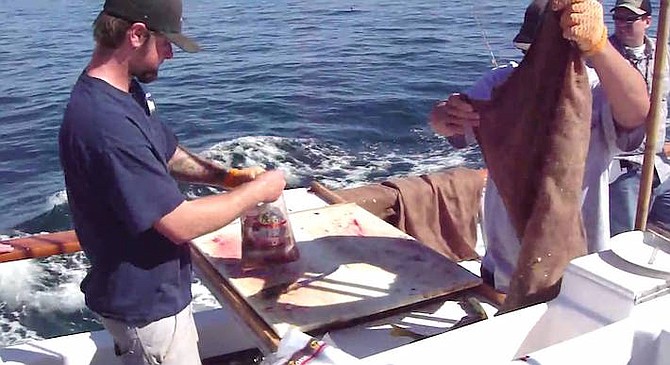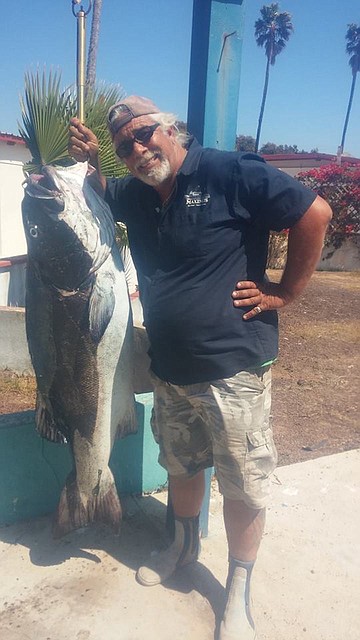 Facebook
Facebook
 X
X
 Instagram
Instagram
 TikTok
TikTok
 Youtube
Youtube

Dock Totals August 20 – August 26: 6,921 anglers aboard 255 boats out of San Diego landings this past week caught 1,749 bluefin tuna, 2,022 yellowfin tuna, 508 skipjack tuna, 1,032 dorado, 12,916 yellowtail, 1,045 calico bass, 88 sand bass, 1,080 rockfish, 17 lingcod, 4,167 bonito, 135 barracuda, 6 sculpin, 46 whitefish, 61 sheephead, 3 rubberlip seaperch, 1 California corbina, 8 halibut, 9 mako shark, 7 thresher shark, 2 shortbill spearfish, and 1 striped marlin.

Saltwater: Yellowtail continue to dominate the fish counts offshore up and down the coast. Bluefin tuna have started showing very well in the 20- to 40-pound range with some of the big brutes 100 pounds or more. Problem here is you’ll need to have a quiver of rods so as to be ready for the class of fish the boat is on. If the schoolie tuna, dorado or yellowtail, then a 30-pound bait or 40-pound jig stick set-up is best. If the fish are the large bluefin, then anglers will need to have something on hand with at least 60- or 80-pound line test to handle them. Flat-falls seem to still be the go-to jig on the big bluefin and have been working well on the rest of the pelagics with the exception of dorado as they tend to stay in the most upper zone in the water column. Of the flat-falls, glow-in-the-dark is the best, and re-rigging the hooks to a larger size is advised.
This past week’s angler total and fish count has been going so well that a few operators are looking for deck crew to fill the spots of returning students.
A few black seabass have been caught and released lately (they are protected in U.S. waters). One thing about these giants that can grow to over 400 pounds is that they tend to fight hard until the last, then, by the time you see the fish, it is rolling — giving up and lying on the surface. For a successful release. Here, one needs to right the fish to its natural swimming position and get plenty of water moving through its gills. As the air bladder is probably expanded, you need to give the fish some time to adjust to the depth naturally. If the bladder does not compress, then some try to perforate it, or use a few weighs on a break-away barbless hook to get it down a little at a time and then break off the hook and retrieve the weights when the fish swims down on its own. A successful release can be done as we do marlin. Put the boat in gear, hold the fish upright and steady, and let the slow movement of the boat push the reviving water through the mouth and out the gills. When the fish starts looking revived and can hold itself upright, put the boat in neutral and release the fish.
Black seabass are still legal to keep south of the border, but there is no way to prove where it was caught. It was thick in numbers in the nearshore waters off San Diego (along with broomtail grouper). The Bottom Scratchers were the first to notice the fast-shrinking numbers of our coastal giants. They quit hunting them and the broomtails altogether. A popular area where they are still caught and kept is along the northern stretch of the Pacific coast of the Baja peninsula. In the waters near San Quintin, large fish of 200 pounds or more are scaught and many juveniles caught in the area indicate a healthy black seabass population along the rocky, kelp bed shoreline.
Top boats of the week:
Aug. 26 –The Pacific Dawn carrying 17 anglers on a 2 day trip reported limits of 68 bluefin tuna and 5 yellowtail caught.
Aug. 25 – Another legendary run for the Legend as 30 anglers aboard their 2 day trip scored 50 skipjack tuna, 20 dorado, 248 yellowfin tuna and 51 yellowtail. The Pacific Voyager’s 15 anglers aboard their 2 day trip caught limits of 60 bluefin tuna and 150 yellowtail.
Aug. 24 – 54 anglers aboard the San Diego ¾ day run put limits of 270 yellowtail in their gunnysacks, along with 48 bonito and 26 bluefin tuna. Now that’s some good ¾ day fishing!
Aug. 23 – 21 anglers aboard the Pacific Queen caught 84 bluefin tuna and140 yellowtail. The Alicia reported 10 calico bass, 1 California corbina, 1 halibut, 25 bonito, 1 yellowfin tuna and 61 yellowtail for the 14 anglers aboard their ¾ day run. I’m wondering, seriously, if that’s a first: a California corbina and a tuna on the same boat. Corbina are usually caught in less than 20 feet of water, tuna, usually more than a couple miles off the coast in a few hundred feet of water.
Aug. 22 – 34 dorado, 85 yellowfin tuna, and 34 yellowtail were caught by the 17 anglers aboard the Fortune 1.5 day trip. The Pacific Star called in with 102 yellowtail, 2 dorado and limits of 84 bluefin tuna caught by the 21 anglers aboard their 2.5 day trip.
Aug. 21 – 31 anglers aboard the Condor 2.5 day trip caught 139 yellowtail, 56 dorado and 127 yellowfin tuna.
Aug. 20 – The Mission Belle returned to the dock with limits of 100 California yellowtail along with a nice ¾ day bonus of 13 bluefin tuna.
Fish Plants: No plants this week.


Dock Totals August 20 – August 26: 6,921 anglers aboard 255 boats out of San Diego landings this past week caught 1,749 bluefin tuna, 2,022 yellowfin tuna, 508 skipjack tuna, 1,032 dorado, 12,916 yellowtail, 1,045 calico bass, 88 sand bass, 1,080 rockfish, 17 lingcod, 4,167 bonito, 135 barracuda, 6 sculpin, 46 whitefish, 61 sheephead, 3 rubberlip seaperch, 1 California corbina, 8 halibut, 9 mako shark, 7 thresher shark, 2 shortbill spearfish, and 1 striped marlin.

Saltwater: Yellowtail continue to dominate the fish counts offshore up and down the coast. Bluefin tuna have started showing very well in the 20- to 40-pound range with some of the big brutes 100 pounds or more. Problem here is you’ll need to have a quiver of rods so as to be ready for the class of fish the boat is on. If the schoolie tuna, dorado or yellowtail, then a 30-pound bait or 40-pound jig stick set-up is best. If the fish are the large bluefin, then anglers will need to have something on hand with at least 60- or 80-pound line test to handle them. Flat-falls seem to still be the go-to jig on the big bluefin and have been working well on the rest of the pelagics with the exception of dorado as they tend to stay in the most upper zone in the water column. Of the flat-falls, glow-in-the-dark is the best, and re-rigging the hooks to a larger size is advised.
This past week’s angler total and fish count has been going so well that a few operators are looking for deck crew to fill the spots of returning students.
A few black seabass have been caught and released lately (they are protected in U.S. waters). One thing about these giants that can grow to over 400 pounds is that they tend to fight hard until the last, then, by the time you see the fish, it is rolling — giving up and lying on the surface. For a successful release. Here, one needs to right the fish to its natural swimming position and get plenty of water moving through its gills. As the air bladder is probably expanded, you need to give the fish some time to adjust to the depth naturally. If the bladder does not compress, then some try to perforate it, or use a few weighs on a break-away barbless hook to get it down a little at a time and then break off the hook and retrieve the weights when the fish swims down on its own. A successful release can be done as we do marlin. Put the boat in gear, hold the fish upright and steady, and let the slow movement of the boat push the reviving water through the mouth and out the gills. When the fish starts looking revived and can hold itself upright, put the boat in neutral and release the fish.
Black seabass are still legal to keep south of the border, but there is no way to prove where it was caught. It was thick in numbers in the nearshore waters off San Diego (along with broomtail grouper). The Bottom Scratchers were the first to notice the fast-shrinking numbers of our coastal giants. They quit hunting them and the broomtails altogether. A popular area where they are still caught and kept is along the northern stretch of the Pacific coast of the Baja peninsula. In the waters near San Quintin, large fish of 200 pounds or more are scaught and many juveniles caught in the area indicate a healthy black seabass population along the rocky, kelp bed shoreline.
Top boats of the week:
Aug. 26 –The Pacific Dawn carrying 17 anglers on a 2 day trip reported limits of 68 bluefin tuna and 5 yellowtail caught.
Aug. 25 – Another legendary run for the Legend as 30 anglers aboard their 2 day trip scored 50 skipjack tuna, 20 dorado, 248 yellowfin tuna and 51 yellowtail. The Pacific Voyager’s 15 anglers aboard their 2 day trip caught limits of 60 bluefin tuna and 150 yellowtail.
Aug. 24 – 54 anglers aboard the San Diego ¾ day run put limits of 270 yellowtail in their gunnysacks, along with 48 bonito and 26 bluefin tuna. Now that’s some good ¾ day fishing!
Aug. 23 – 21 anglers aboard the Pacific Queen caught 84 bluefin tuna and140 yellowtail. The Alicia reported 10 calico bass, 1 California corbina, 1 halibut, 25 bonito, 1 yellowfin tuna and 61 yellowtail for the 14 anglers aboard their ¾ day run. I’m wondering, seriously, if that’s a first: a California corbina and a tuna on the same boat. Corbina are usually caught in less than 20 feet of water, tuna, usually more than a couple miles off the coast in a few hundred feet of water.
Aug. 22 – 34 dorado, 85 yellowfin tuna, and 34 yellowtail were caught by the 17 anglers aboard the Fortune 1.5 day trip. The Pacific Star called in with 102 yellowtail, 2 dorado and limits of 84 bluefin tuna caught by the 21 anglers aboard their 2.5 day trip.
Aug. 21 – 31 anglers aboard the Condor 2.5 day trip caught 139 yellowtail, 56 dorado and 127 yellowfin tuna.
Aug. 20 – The Mission Belle returned to the dock with limits of 100 California yellowtail along with a nice ¾ day bonus of 13 bluefin tuna.
Fish Plants: No plants this week.
Comments